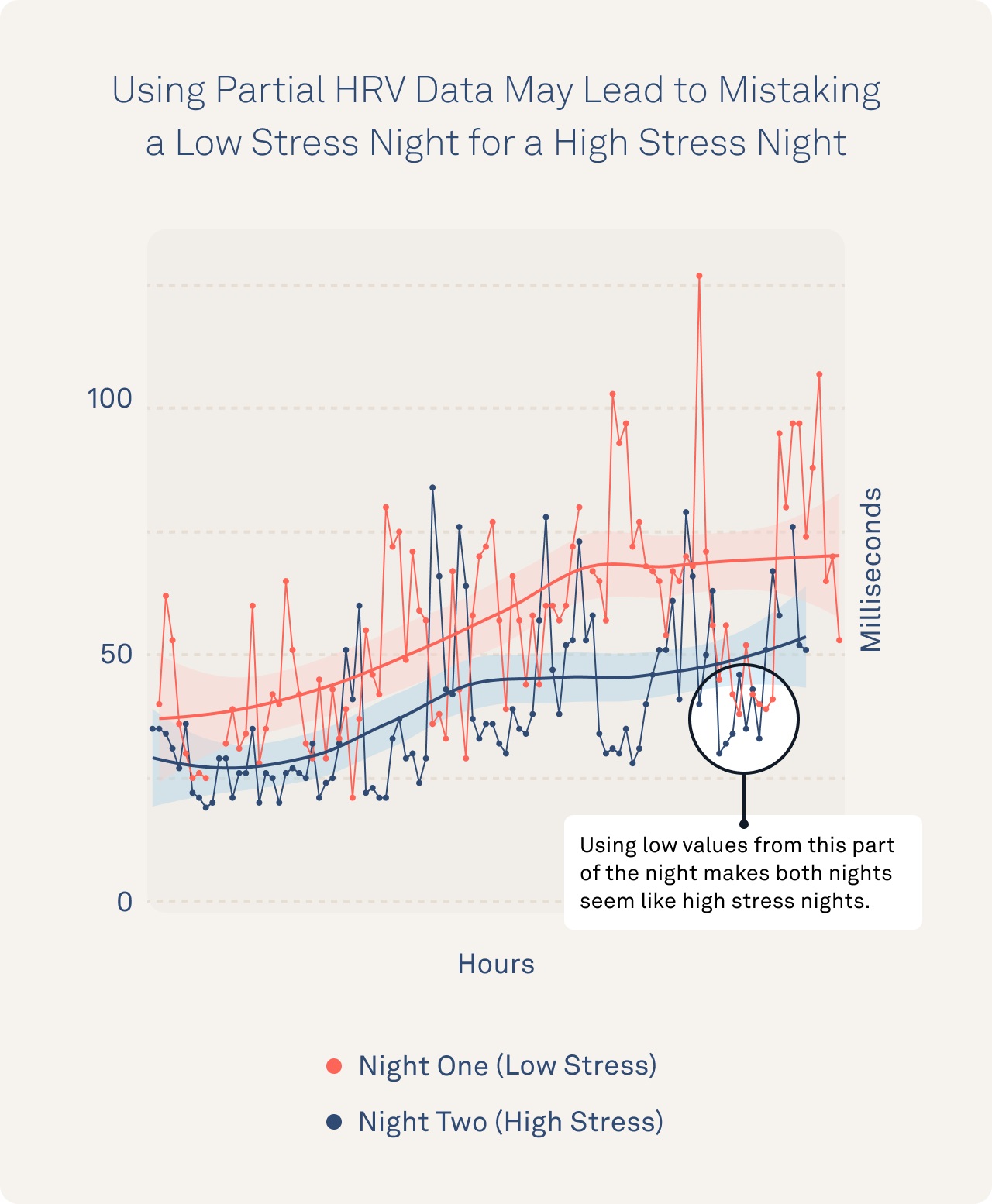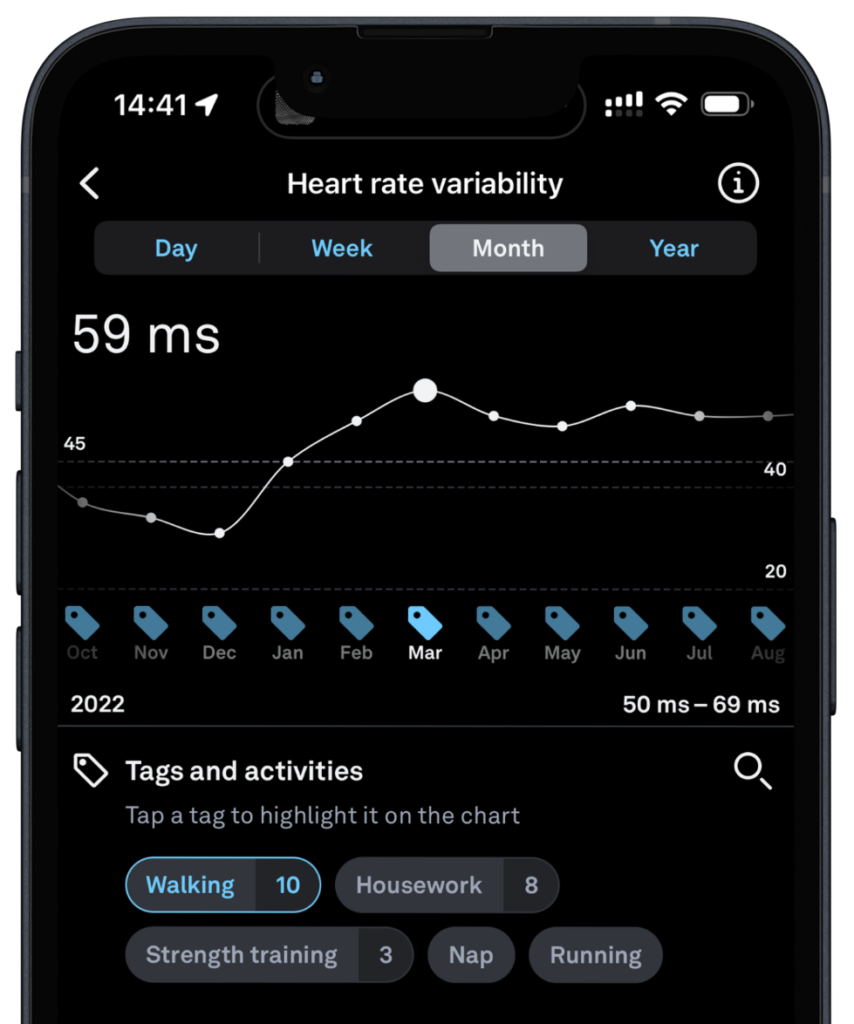- A highly individual and nuanced biometric, heart rate variability (HRV) measures the variation in time between heartbeats.
- Common HRV myths include the misconception that it is the same as resting heart rate, that higher HRV is always better, and that HRV status is controlled by the heart rather than the autonomic nervous system.
- Oura members can track HRV status and trends over time rather than daily fluctuations, compare HRV to personal baselines, and monitor other related health metrics like VO2 max and daily stress levels.
Heart rate variability (HRV) is a powerful biometric tracked by Oura that offers a unique glimpse into your health. However, it’s often misunderstood.
Keep reading to learn more about this nuanced metric, and clear up some of the most common misconceptions with Marco Altini, PhD, one of the world’s leading HRV experts and Oura data science advisor.
What is HRV? A Brief Explanation
HRV is the variation in time between your heartbeats. While you might assume that a consistent, regular heartbeat is ideal, the truth is that variability (sometimes faster, sometimes slower) indicates a heart that is responsive and adaptive.
Having a relatively higher HRV (or more variation between heartbeats) generally indicates a well-functioning autonomic nervous system (ANS), as both branches — the sympathetic and parasympathetic — are engaged in response to stress, rest, and bodily demands. Conversely, a lower HRV means one branch, usually the sympathetic (“fight-or-flight”), is dominating.
READ MORE: How Stress Works: The Mind-Body Connection
Myth #1: HRV is the same as resting heart rate.
Despite both metrics involving the heart, they are not interchangeable. Resting heart rate is the number of times your heart beats per minute while at rest. HRV measures the variability in time between consecutive heartbeats within the same period.
“Even if we count 60 beats in a minute, they do not happen exactly every second,” explains Altini. “HRV can better capture parasympathetic activity by measuring changes in your resting heart rate.”
READ MORE: HRV and Stress: What HRV Can Tell You About Your Mental Health
Myth #2: For HRV, higher is better.
“Generally, a higher HRV tends to be preferable,” says Altini, “but it’s complicated.” There is no universal HRV benchmark. A lower HRV isn’t necessarily bad since HRV is highly individualized.
Factors like illness, stress, tough workouts, and pregnancy can lower HRV, indicating your body needs more recovery. Additionally, some factors beyond your control, such as medical conditions, menstruation, gender, and age, can also affect your HRV baseline.
“Having a stable HRV is often a more effective goal than aiming for a high HRV,” advises Altini.
| Member Tip: Compare your HRV to your personal baseline, not population averages. That’s why Oura monitors HRV Balance to see how well you maintain a stable HRV over time. |
Myth #3: HRV is modulated by the heart.
HRV is actually controlled by the autonomic nervous system (ANS), which regulates heart rhythm in response to stress. “The heart’s pacemaker, known as the sinoatrial node, generates heartbeats, but the ANS causes fluctuations,” Altini explains.
“If we had no other mechanism to modulate heart rhythm, our heart would beat at about 100 bpm due to this pacemaker. The ANS adjusts this rate, causing variability,” he says.
READ MORE: HRV and Stress: What HRV Can Tell You About Your Mental Health
Myth #4: Your HRV increases when you meditate.
The truth: Meditation probably won’t increase HRV immediately. In fact, it may lower initially — but it may help it increase over time.
As Altini explains, “When you try something new, particularly something that forces you to slow down and be still, it can be stress-inducing. Underlying thoughts may surface, and you may have to force yourself to continue with the practice — this increases stress.”
However, regular meditation over months or years can reduce stress and increase parasympathetic tone, ultimately raising HRV. Like weightlifting, one session isn’t enough to see significant changes!
Myth #5: A low HRV may indicate heart problems.
There isn’t a clear connection between low HRV and heart problems. Studies have shown both low and high HRV can be linked to heart issues.
For example, one study found that an abnormally high HRV was linked to atrial fibrillation, while another study found that an abnormally low HRV was associated with an increased risk for myocardial ischemia.
If your HRV is stable and within the normal range (anywhere from below 20 to over 200 milliseconds), there is no strong evidence to suggest a lower HRV is an indication of heart problems.
READ MORE: What Is the Average HRV?
Myth #6: A more regular heart rate is better.
Stress causes your heart rate to increase and become more stable and regular as part of the “fight-or-flight” response. When you recover, a neurotransmitter known as acetylcholine slows your heart rate and increases HRV almost instantly.
In other words: A very regular heart rate can indicate one branch of your ANS is dominating, resulting in lower HRV, while more variation indicates that your ANS is agile and responsive.
| Member Tip: Oura tracks HRV, motion, skin temperature, and resting heart rate to give insights into your daily stress levels. Learn more about the Daytime Stress feature here. |
Myth #7: HRV is a marker of cardiovascular fitness.

“HRV mainly tells you how you are handling stress,” says Altini. “In fact, you may notice your HRV is suppressed the day after exercise because exercise is a type of stress.”
Even professional athletes can have HRV on the lower end of average due to intense training.
However, exercise can improve your HRV over time, particularly if you are not currently active. Exercise promotes healthy changes in body composition, improvements in cardiovascular health, and lower stress levels — all factors that can improve HRV.
| Member Tip: Monitor your Cardio Capacity (VO2 Max) on Oura. VO2 Max is a highly accurate indicator of cardiovascular fitness, so focus on this metric rather than HRV. |
Myth #8: It’s more accurate to measure your HRV during the day.
Measuring HRV at night is usually more accurate. Daytime movement impacts accuracy, whereas sleep provides a state of rest with minimal influences, offering a more reliable reflection of your ANS baseline.
| Member Tip: Oura measures your HRV every five minutes while you sleep, and the morning HRV reading is the average of all these nighttime samples. |

LEARN MORE: Why Oura Uses The Entire Night Of HRV Data
 Myth #9: You should track your daily HRV.
Myth #9: You should track your daily HRV.
Tracking HRV trends over time is more helpful than focusing on daily fluctuations. Your HRV trend on the Oura App shows how you handle stress over time, while daily values can vary based on activities like workouts, alcohol consumption, or sleep quality.
“Your HRV remains relatively stable. It’s unlikely to change drastically in your lifetime,” says Altini. “However, small adjustments like regular meditation or exercise may improve your HRV over time.”
| Member Story: Marathon runner Raj K. started incorporating low-intensity runs. After six months, he saw that his HRV had increased from the low 30s to the 40s. |
RELATED: How To Improve Your HRV (Heart Rate Variability)
About the Oura Expert
Marco Altini, PhD, holds a PhD cum laude in applied machine learning, a M.Sc. cum laude in computer science engineering, and a M.Sc. cum laude in human movement sciences and high-performance coaching. He has published more than 50 papers and patents at the intersection between physiology, health, technology, and human performance. He is co-founder of HRV4Training, advisor at Oura, guest lecturer at VU Amsterdam, and editor for IEEE Pervasive Computing Magazine. He loves running.





